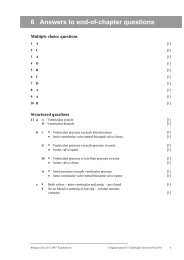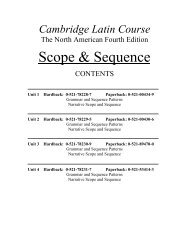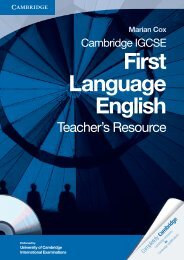Brad Philpot - Cambridge University Press
Brad Philpot - Cambridge University Press
Brad Philpot - Cambridge University Press
Create successful ePaper yourself
Turn your PDF publications into a flip-book with our unique Google optimized e-Paper software.
Part 3 – Literature: texts and contexts<br />
152<br />
ODLID about gulag in 1950s. Today – Abu Ghraib.<br />
Explanation People will always fear oppression.<br />
Body paragraph 3<br />
Point HT cleverly crafted and therefore timeless.<br />
Illustration Stream of consciousness and clever epilogue.<br />
Explanation Style and structure suitable for dystopian literature.<br />
Body paragraph 4<br />
Point ODLID cleverly crafted and therefore timeless.<br />
Illustration Not memoir: historical novel for a reason – risk of imprisonment.<br />
Explanation Free indirect speech puts author at safe distance from main character<br />
but draws reader in.<br />
Conclusion<br />
Summary Timeless themes – oppression and dignity. Style and structure suit genre.<br />
Put ideas into greater context and/or link to ideas from introduction Reasons<br />
why we always return to writers such as Shakespeare.<br />
Attention grabber<br />
Try to capture your reader’s attention immediately, by using a bold statement, a<br />
question, a quote or a brief anecdote in the first line of the introduction. (It is also<br />
important that you first write out the question that you are responding to at the top of<br />
the essay. This will help both you and the examiner.)<br />
Factual information<br />
In the opening paragraph state briefly what the essay will respond to. Just as in a letter<br />
to the editor you find the name of the article, the date of publication and author of<br />
the article the letter responds to, similarly in a literature essay you should give the title<br />
of the text or texts and author’s name. This can be done in passing, as in the sample<br />
student response.<br />
Thesis<br />
A thesis statement captures the main idea and purpose of the essay. Half of the thesis<br />
is given to you in the Paper 2 exam question. The other half will be your answer to<br />
the question. Thesis statements are clear, succinct and persuasive. The sample student<br />
response suggests two reasons why literary works have received continued interest:<br />
timeless themes and strong literary devices. This thesis already provides a structure for<br />
the rest of the essay. Furthermore, notice how the sample student response mentions<br />
the titles of the works, the author’s names and the thesis in one fluid statement. There<br />
is no weak or over-obvious wording such as In this essay I will … or My essay is about<br />
question number … Avoid the word I and make a strong statement.<br />
Sample<br />
Topic sentence (point)<br />
Body paragraphs start with a topic sentence in which the first point is made. A topic<br />
sentence refers to one of the main ideas of the thesis statement. For this reason it is<br />
effective if the thesis statement consists of two or three components. The topic sentence<br />
© <strong>Cambridge</strong> <strong>University</strong> <strong>Press</strong> 2011








